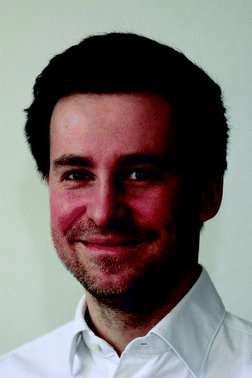Materials Horizons Emerging Investigator Series: Dr Filip Podjaski, Max-Planck-Institute for Solid State Research, Germany
Being passionate about natural sciences since my childhood, I studied physics with a focus on materials in Göttingen (Germany) and Lyon (France). Out of interest also for chemistry, renewable energy, and solar fuel production, I joined Prof. Lotsch's Nanochemsitry department at the Max-Planck-Institute for Solid State Research for a joint PhD with the Laboratory of Semiconductor Materials at EPFL, working on photocatalysis, electrocatalysis for water splitting, and solar battery materials. I stayed in the Nanochemistry department at MPI as a postdoc and now group leader, mainly to continue exploring fundamental aspects and new technological possibilities arising from organic materials that have intrinsic solar energy storage properties. My research and interests are very interdisciplinary – I try to connect understanding from physics and chemistry to enhance material properties or functions, and to bridge this knowledge for applications in new areas, such as in solar fuel production, biophysics or micro-robotics.
Read Filip Podjaski's Emerging Investigator Series article ‘Photomemristive sensing via charge storage in 2D carbon nitrides’ ( https://doi.org/10.1039/D2MH00069E ) and read more about him in the interview below:
MH: Your recent Materials Horizons Communication demonstrates a multimodal photomemristive sensing concept through charge storage in 2D carbon nitrides. How has your research evolved from your first article to this most recent article and where do you see your research going in future?
FP: My research evolved from electro- and photo-catalysis for solar fuel production, with intrinsic solar energy storage (solar battery materials) being the basis for this manuscript. Together with colleagues in the Nanochemistry department and collaborators, we could drive forward more broad studies of properties and applications. These include microrobotics and new technologies for information processing. This manuscript highlights the ability to perform sensing using intrinsic solar energy storage for the memory function. In future, I want to focus my research on better understanding and tailoring of light driven charge storage effects intrinsically coupled in materials. The aim is to enable more versatile and economically viable solar batteries and related technologies, which are relevant for a more sustainable world.
MH: What aspect of your work are you most excited about at the moment?
FP: I am most excited by how many energy related technologies can nowadays be addressed with organic materials. Such materials are often challenging to understand, but they pave the road for more sustainable and versatile technological advancement. What excites me particularly is how such functionality can be embedded in organic materials, and how they can be used in a biomedical context in future. Since our photomemristive sensor also accumulates free energy, it could be used for the stimulation of further action, like a neuron. All of this is very interdisciplinary research, and it is very exciting to learn about different perspectives from colleagues.
MH: In your opinion, what are the most important questions to be asked/answered in this field of research?
FP: As a physicist, I think we still lack some fundamental understanding of how intrinsic solar energy storage functionalities are actually realized on an atomic interaction scale, and why/which photophysical properties are affected. With this knowledge, we could tailor future energy storage devices and their properties much better, perhaps even from the bottom-up in the case of organic polymers or networks. With regards to this sensor – we need to find ways to make it more selective with respect to analytes, and to better stabilize the information storage.
MH: What do you find most challenging about your research?
FP: A challenge is often to get well defined samples for (photo)electrochemical characterization on difficult to process materials. Another challenge I often face is to align my “physical” image about the science going on inside materials and during energy conversion with that of the chemists I mainly work with, especially when discussing organic-based semiconductor materials. We often take a long time to converge the right language, descriptions and desired experiments – but once we all align, it feels great and everyone learns a lot. The “diversity challenge” is what I appreciate most in interdisciplinary science.
MH: In which upcoming conferences or events may our readers meet you?
FP: GRS/GRC Electronic Processes in Organic Materials (June 2022, Tuscany, Italy), Materials Science and Engineering (MSE) Congress 2022 (September, Darmstadt, Germany) and perhaps IPS-23 (August, EPFL, CH).
MH: How do you spend your spare time?
FP: I like to travel and to discover new places and cultures, to meet and chat with friends and family, to read, and I enjoy board games a lot.
MH: Can you share one piece of career-related advice or wisdom with other early career scientists?
FP: Get as much advice from more experienced people as you can, but still follow your own interests and dreams. Focus mostly on what you are passionate about – that is probably where you will be better than others. And keep discussing and working as much as possible with other scientists so you never stop learning.
| This journal is © The Royal Society of Chemistry 2022 |

